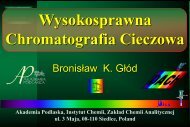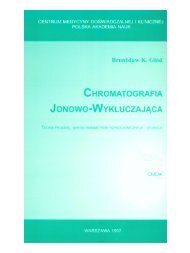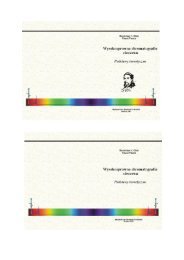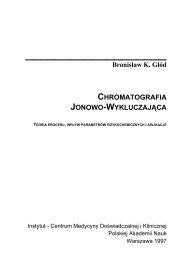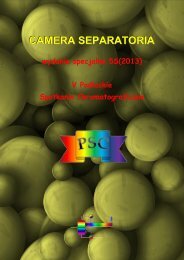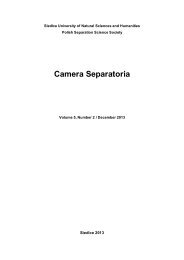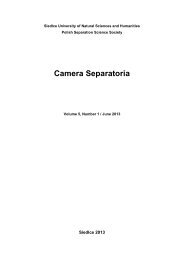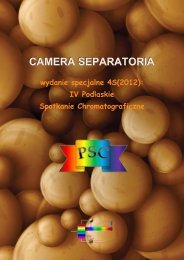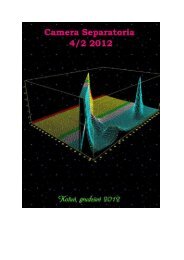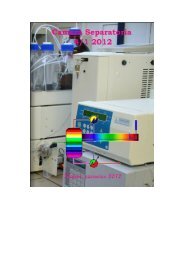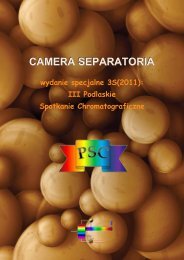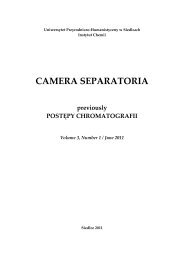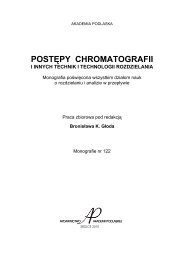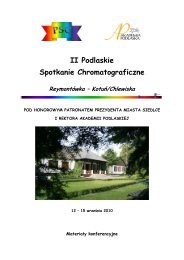CamSep 3 2
You also want an ePaper? Increase the reach of your titles
YUMPU automatically turns print PDFs into web optimized ePapers that Google loves.
Opracowanie optymalnych warunków rozdzielania i identyfikacji metabolitów roślin…<br />
295<br />
Rozdzielenie naftochinonów z zastosowaniem acetonitrylu okazało się<br />
selektywne, aczkolwiek współczynniki k substancji rozdzielonych były<br />
znacznie większe niż w przypadku izopropanolu czy THF.<br />
Do opracowania możliwie optymalnego programu elucji do rozdzielania<br />
i oznaczania składników ekstraktów roślinnych wybrano wodę z kwasem<br />
oraz składniki organiczne: metanol i izopropanol. Metanol, ponieważ<br />
selektywnie rozdzielał flawonoidy, izopropanol, gdyż selektywnie<br />
rozdzielał naftochinony.<br />
Dla ekstraktów z D. capensis i D. binata program elucji wymaga jeszcze<br />
pewnych modyfikacji, które sprawią iż rozdzielenie zawartych w nich<br />
substancji będzie bardziej selektywne, co pozwoli rozdzielić więcej substancji.<br />
Trudne, a w wielu przypadkach niemożliwe jest opracowanie uniwersalnej<br />
metodyki rozdzielania ekstraktów roślin różnych gatunków, które<br />
często wykazują znaczne różnice składu jakościowego i ilościowego.<br />
Summary<br />
The research on using binary mixtures as eluent for separation of<br />
plant extracts D. muscipula i D. aliciae with HPLC gave conclusions, which<br />
are listed below:<br />
Isopropanol as a component of the eluent gives him an adequate elution<br />
strength, furthermore its application gives selective conditions for<br />
separation of flavonoids and naphthoquinones from other accompanying<br />
compounds,<br />
The k values of substances from chromatographed extracts with the<br />
use of isopropanol are in optimal range from 1 to 10,<br />
Methanol as component of the eluent has weak elution strength, however<br />
very selective conditions for separation of flavonoid compounds<br />
were reported,<br />
The chromatographic system in which the acetonitrile was used has<br />
a selective properties for separation of quercetin in respect to other<br />
components in Dionaea muscipula extract and of myricetin in respect to<br />
other compounds of Drosera aliciae extract,<br />
The separation of naphthoquinones with the use of acetonitrile was selective,<br />
however the k values of separated substances were much higher<br />
than with the use of isopropanol or THF,<br />
The optimal composition of the eluent for optimal elution program for<br />
separation and identification of plant extracts components must include<br />
water with acid addition and organic components: methanol and isopropanol.<br />
Methanol gives selective properties for separation of flavonoids<br />
and isopropanol for separation of naphthoquinones,<br />
For D. capensis and D. binata extracts the elution program needs much<br />
more modifications, which influence its properties for selective separation<br />
of more components of the extracts,<br />
Vol. 3, No 2/2011<br />
Camera Separatoria




